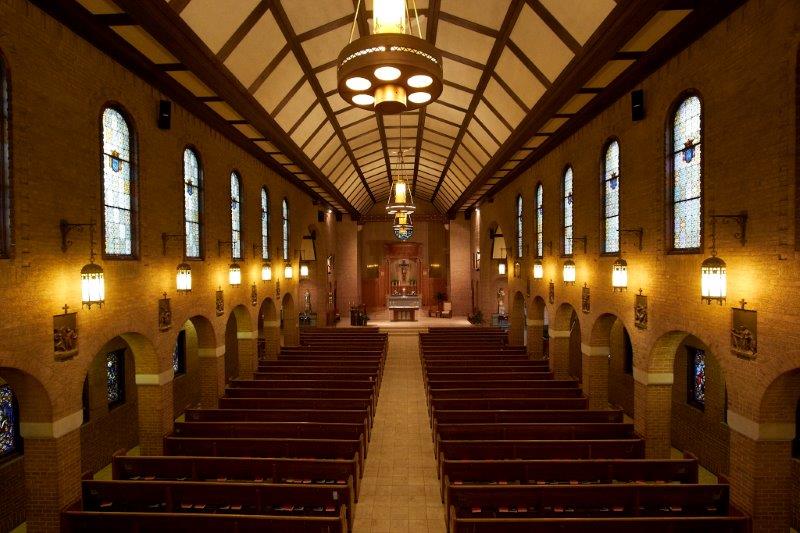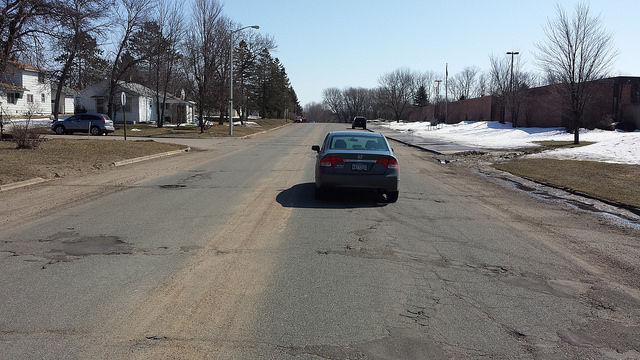Living in communion
Church leaders around the country should be doing everything they can to reconnect the social bonds of our communities. We reconnect the social bonds most easily and effectively when we reconnect the physical bonds. We should be obsessed with getting people out of their cars and back into each other’s lives.
If you are not already a member of Strong Towns, you really need to be. We’re pushing the boundaries on reforming our cities, our finances, our transportation system, leading a national conversation on how to build a strong America. We are taking these powerful ideas and turning them into action and we need your support to make it happen. Don’t put it off any longer -- become a member today.
I wasn’t expecting this Sunday’s preaching to include an anti- bike lane message, but nonetheless, as I sat there yesterday with my family in the third row at St. Andrews Catholic Church, I received just that. The priest let us know that there would be a meeting tonight (Monday) in which the city council would be asked to determine which side of the street would lose parking in order to accommodate a bike lane. I was so perplexed, I almost took the Lord’s name in vain (and during Lent, no less).
My perplexity resides on many levels. First, this comes just a month after I had bought my priest a copy of Eric Jacobsen’s Sidewalks in the Kingdom (The Christian Practice of Everyday Life) and shared with him some written thoughts on how we, as a parish, could serve our neighbors by starting a dialog on walking and biking within the community. I was prompted to reach out to him after a sermon in which he referenced the seminal work by Robert Putnam, Bowling Alone (which I’ve also read – incredible).
In a fantastic and inspiring sermon, our priest lamented some of the community challenges outlined by Putnam, a sentiment I shared when I read Bowling Alone over a decade ago. That book, and other experiences, started me on an obsession with learning more about early Christian communities and how they influenced Christian teaching. I’m not an ideal parishioner nor a very good Catholic – God gave me a brain more prone to question than obey – but I’ve found a lot of comfort in how the simple message of Jesus to love one’s neighbor as oneself can be applied to make all of our communities a little stronger.
I probably should have made an appointment to go and meet with our priest, but I’m a writer more than a conversationalist and so, on matters this close to home, I tend to either write or just stay silent. There was nothing really secret or personal about the letter I wrote, so I’ve shared it over on our member discussion board. In that letter, you’ll find this statement (more of a humble challenge):
When we resist the urge to tear down buildings for more parking, we may inconvenience our parishioners who have to walk a block to get to church, but we provide more opportunity for people who want to live with a deep, physical connection to the church.
My hometown has two Catholic churches. We used to go to the one on the north side but, when the kids were born, we found ourselves perpetually late for the 9:00 AM mass, at which point we would drive to the other church on the south side and arrive in plenty of time for the 9:30 AM mass. We found we liked the south side church and decided to save ourselves the stress by just start going to the later mass.
 The interior of St. Francis church in Brainerd, MN.The north side church – beautifully christened St. Francis – is a cathedral style building. Growing up I was always in awe of the columns and the arches and the stained glass. It just seemed so magnificent. We still do Christmas service there because I have so many great memories. The magnificence of St. Francis church used to be snuggled into a traditional neighborhood, with the school and the rectory and lots of housing surrounding it. Over the years, the church has purchased and removed a lot of these properties to build – what else – parking lots. Plans were unveiled last year for expansion of the church which would include – what else – more parking.
The interior of St. Francis church in Brainerd, MN.The north side church – beautifully christened St. Francis – is a cathedral style building. Growing up I was always in awe of the columns and the arches and the stained glass. It just seemed so magnificent. We still do Christmas service there because I have so many great memories. The magnificence of St. Francis church used to be snuggled into a traditional neighborhood, with the school and the rectory and lots of housing surrounding it. Over the years, the church has purchased and removed a lot of these properties to build – what else – parking lots. Plans were unveiled last year for expansion of the church which would include – what else – more parking.
Bowling Alone rings like a steeple bell in my head. We’re disconnected from each other today in many ways that baffle those who examine the symptoms. We don’t join community groups. We have less fellowship with each other. We may come together for a Sunday mass, but we’re not deeply involved in each other’s lives. Is the Church part of this or just a passive observer dealing with the fallout?
It is more than a little ironic that I’ve had more conversations with our next door neighbors of the past sixteen years in the brief moments walking in and out of church than I’ve ever had on our street or, perhaps more amazingly, in each other’s homes. When either of us travel to church, we back out of our garages, hit the automatic garage door opener to close it, drive to church, park in one of the convenient parking lots, attend church and then do the trip home in reverse. Essentially, we’re Churching Alone.
The south side church is named St. Andrews. It has none of the “limitations” (or grandeur) of St. Francis. It was built in the 1960’s with the typical architecture of the time; horizontal construction in a field on the edge of town with lots of parking. It met all the needs of the new, auto-based parishioner who could arrive by car, avoid the traffic rush by leaving right after communion – but before the closing hymn – and be home by kickoff. While the church can be a vibrant and communally beautiful place at times, those times are always intentional. There is no passive, deep church community vibrating in and around St. Andrews.
 St. Andrews church in Brainerd, MN. Click to explore the area in Google.
St. Andrews church in Brainerd, MN. Click to explore the area in Google.
It is this south side church that is now “threatened” by the bike lanes. I am running out of room here to describe how ridiculously stupid the city staff, and perhaps the council, is being – and I’ve held back on using terms like “stupid” to describe them but it’s all just too much to bear sometimes – so I’m going to do a follow up post and explain what’s going on. What we were told in church today is that the city is fixing the street, that they want to add a bike lane and that, in order to do so, they need to remove parking along one side of the street. Here’s a photo of the street. See if you can resist the urge to take the Lord’s name in vain.
 Willow St. in front of the church. It is 44 feet wide with little traffic.
Willow St. in front of the church. It is 44 feet wide with little traffic.
Of course, church leaders are upset – and encouraging parishioners to attend the council meeting and be heard – at the idea that parking could be reduced on their side of the street. The announcement said that we would be “forced” to buy more parking if that were to happen. I think parking ratios are found in Leviticus, a book we refer to occasionally when it suits our needs. (It’s also worth noting that the church is not paying any taxes to the city, despite fronting nearly 1,500 feet of public roadway.)
I’ll say again, I’m not a very good parishioner nor am I even a very good Catholic. Of all the people in my church to stand up and complain about our focus and priorities, I have probably the least right of any. I attend mass when I can. I sometimes stay after and socialize a little during coffee hour. I don’t volunteer very often – the church is 15 miles away from my actual house – and I don’t find myself drawn to attend the socials and scheduled get-togethers. Besides my family and a handful of high school friends, I don’t really even know many people there, despite having attended my entire life. These are regrets. They are also reality.
So here’s the question: how many other parishioners are just like me? How many would like a deeper connection with the Church but just don’t find it convenient in this hectic world, ample parking or not? How many live isolated in their easily accessible homes, finding more sense of community in their Costco membership than their parish? After all, there’s plenty of parking there too.
I’ve long wondered just how much more fulfilling our lives would be if we did not live in such isolation. If God dwells in each of our hearts – and I truly believe that is the case – then seeking to live in communion with God should mean that we seek to have lives immersed with each other. To truly live in this way cannot be an active pursuit, one in which we have to get in the car and drive 25 minutes to a parking lot at a set time for a scheduled event with a self-selected group of people. It must be passive, where our natural day-to-day existence includes random interactions with the humanity that makes up our community, be they Christian or not. Be they affluent enough to own a car or not.
Not only should we not be opposing bike lanes, church leaders around the country should be doing everything they can to reconnect the social bonds of our communities. We reconnect the social bonds most easily and effectively by reconnecting the physical bonds. We should not only be building bike lanes, we should be obsessed with getting people out of their cars and back into each other’s lives.
That’s a Strong Towns thing to do. I humbly suggest that it is also a Christian thing to do.
The latest from Chuck Marohn – MoneyHall – is set to be released in May. Sign up to be notified when it is available on Chuck’s site, MoneyHall.org, and while you are there, check out Thoughts on Building Strong Towns, a great primer on Strong Towns thinking.
